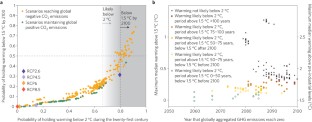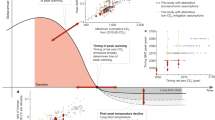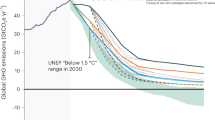Abstract
The Paris Agreement sets a long-term temperature goal of holding the global average temperature increase to well below 2 °C, and pursuing efforts to limit this to 1.5 °C above pre-industrial levels. Here, we present an overview of science and policy aspects related to this goal and analyse the implications for mitigation pathways. We show examples of discernible differences in impacts between 1.5 °C and 2 °C warming. At the same time, most available low emission scenarios at least temporarily exceed the 1.5 °C limit before 2100. The legacy of temperature overshoots and the feasibility of limiting warming to 1.5 °C, or below, thus become central elements of a post-Paris science agenda. The near-term mitigation targets set by countries for the 2020–2030 period are insufficient to secure the achievement of the temperature goal. An increase in mitigation ambition for this period will determine the Agreement's effectiveness in achieving its temperature goal.
This is a preview of subscription content, access via your institution
Access options
Subscribe to this journal
Receive 12 print issues and online access
$209.00 per year
only $17.42 per issue
Buy this article
- Purchase on Springer Link
- Instant access to full article PDF
Prices may be subject to local taxes which are calculated during checkout
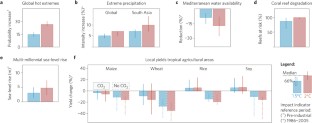
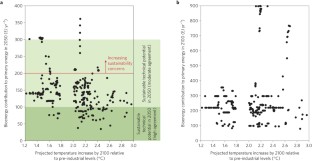
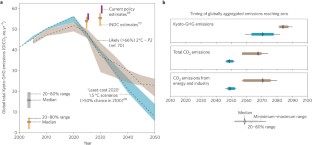
Similar content being viewed by others
References
United Nations Framework Convention on Climate Change (UNFCCC, 1992).
Knutti, R., Rogelj, J., Sedláček, J. & Fischer, E. M. A scientific critique of the two-degree climate change target. Nature Geosci. 9, 13–18 (2015).
Adoption of the Paris Agreement FCCC/CP/2015/10/Add.1 (UNFCCC, 2015).
Hare, W. L., Cramer, W., Schaeffer, M., Battaglini, A. & Jaeger, C. C. Climate hotspots: key vulnerable regions, climate change and limits to warming. Reg. Environ. Change 11, 1–13 (2011).
IPCC Climate Change 2001: Impacts, Adaptation, and Vulnerability (eds McCarthy, J. J., Canziani, O. F., Leary, N. A., Dokken, D. J. & White, K. S.) (Cambridge Univ. Press, 2001).
Smith, J. B. et al. Assessing dangerous climate change through an update of the intergovernmental panel on climate change (IPCC) “reasons for concern”. Proc. Natl Acad. Sci. USA 106, 4133–4137 (2009).
Oppenheimer, M. et al. in Climate Change: Impacts, Adaptation, and Vulnerability (eds Field, C. B. et al.) 1039–1099 (IPCC, Cambridge Univ. Press, 2014).
IPCC Climate Change 2007: Synthesis Report (eds Pachauri, R. K. & Reisinger, A.) (Cambridge Univ. Press, 2007).
Submissions from Parties FCCC/KP/AWG/2009/MISC.1/Add.1 (UNFCCC, 2009).
The Copenhagen Accord FCCC/CP/2009/11/Add.1 (UNFCCC, 2009).
The Cancun Agreements FCCC/CP/2010/7/Add.1 (UNFCCC, 2010).
Report on the Structured Expert Dialogue on the 2013–2015 Review FCCC/SB/2015/INF.1 (UNFCCC, 2015).
Seneviratne, S. I., Donat, M. G., Pitman, A. J., Knutti, R. & Wilby, R. L. Allowable CO2 emissions based on regional and impact-related climate targets. Nature 529, 477–483 (2016).
IPCC Climate Change 2013: The Physical Science Basis (eds Stocker, T. F. et al.) (Cambridge Univ. Press, 2013).
IPCC Managing the Risks of Extreme Events and Disasters to Advance Climate Change Adaptation (eds Field, C. B. et al.) (Cambridge Univ. Press, 2012).
Seneviratne, S. I., Donat, M. G., Mueller, B. & Alexander, L. V. No pause in the increase of hot temperature extremes. Nature Clim. Change 4, 161–163 (2014).
Fischer, E. M. & Knutti, R. Anthropogenic contribution to global occurrence of heavy-precipitation and high-temperature extremes. Nature Clim. Change 5, 560–564 (2015).
Greve, P. et al. Global assessment of trends in wetting and drying over land. Nature Geosci. 7, 716–721 (2014).
Westra, S., Alexander, L. V. & Zwiers, F. W. Global increasing trends in annual maximum daily precipitation. J. Clim. 26, 3904–3918 (2013).
Lehmann, J., Coumou, D. & Frieler, K. Increased record-breaking precipitation events under global warming. Climatic Change 132, 501–515 (2015).
Schleussner, C.-F. et al. Differential climate impacts for policy relevant limits to global warming: the case of 1.5 °C and 2 °C. Earth Syst. Dynam. 7, 327–351 (2016).
Sedláček, J. & Knutti, R. Half of the world's population experience robust changes in the water cycle for a 2 °C warmer world. Environ. Res. Lett. 9, 044008 (2014).
Schewe, J. et al. Multimodel assessment of water scarcity under climate change. Proc. Natl Acad. Sci. USA 111, 3245–3250 (2014).
Rosenzweig, C. et al. Assessing agricultural risks of climate change in the 21st century in a global gridded crop model intercomparison. Proc. Natl Acad. Sci. USA 111, 3268–3273 (2013).
McGrath, J. M. & Lobell, D. B. Regional disparities in the CO2 fertilization effect and implications for crop yields. Environ. Res. Lett. 8, 014054 (2013).
Tai, A. P. K., Martin, M. V. & Heald, C. L. Threat to future global food security from climate change and ozone air pollution. Nature Clim. Change 4, 817–821 (2014).
Challinor, A. J. et al. A meta-analysis of crop yield under climate change and adaptation. Nature Clim. Change 4, 287–291 (2014).
Elliott, J. et al. Constraints and potentials of future irrigation water availability on agricultural production under climate change. Proc. Natl Acad. Sci. USA 111, 3239–3244 (2013).
Bodirsky, B. L. et al. Reactive nitrogen requirements to feed the world in 2050 and potential to mitigate nitrogen pollution. Nature Commun. 5, 3858 (2014).
Deryng, D., Conway, D., Ramankutty, N., Price, J. & Warren, R. Global crop yield response to extreme heat stress under multiple climate change futures. Environ. Res. Lett. 9, 034011 (2014).
Nelson, G. C. et al. Agriculture and climate change in global scenarios: why don't the models agree. Agric. Econ. 45, 85–101 (2014).
Lesk, C., Rowhani, P. & Ramankutty, N. Influence of extreme weather disasters on global crop production. Nature 529, 84–87 (2016).
Asseng, S. et al. Rising temperatures reduce global wheat production. Nature Clim. Change 5, 143–147 (2015).
Pörtner, H.-O. et al. in Climate Change 2014: Impacts, Adaptation, and Vulnerability (Field, C. B. et al.) Ch. 6 (IPCC, Cambridge Univ. Press, 2014).
Gattuso, J.-P. et al. Contrasting futures for ocean and society from different anthropogenic CO2 emissions scenarios. Science 349, aac4722 (2015).
Meissner, K. J., Lippmann, T. & Sen Gupta, A. Large-scale stress factors affecting coral reefs: open ocean sea surface temperature and surface seawater aragonite saturation over the next 400 years. Coral Reefs 31, 309–319 (2012).
Frieler, K. et al. Limiting global warming to 2 °C is unlikely to save most coral reefs. Nature Clim. Change 3, 165–170 (2013).
Hezel, P. J., Fichefet, T. & Massonnet, F. Modeled Arctic sea ice evolution through 2300 in CMIP5 extended RCPs. Cryosphere 8, 1195–1204 (2014).
Burke, M., Hsiang, S. M. & Miguel, E. Global non-linear effect of temperature on economic production. Nature 527, 235–239 (2015).
Mathesius, S., Hofmann, M., Caldeira, K. & Schellnhuber, H. J. Long-term response of oceans to CO2 removal from the atmosphere. Nature Clim. Change 5, 1107–1113 (2015).
Schewe, J., Levermann, A. & Meinshausen, M. Climate change under a scenario near 1.5 °C of global warming: monsoon intensification, ocean warming and steric sea level rise. Earth Syst. Dynam. 2, 25–35 (2011).
Clark, P. U. et al. Consequences of twenty-first-century policy for multi-millennial climate and sea-level change. Nature Clim. Change 6, 360–369 (2016).
Schneider von Deimling, T. et al. Estimating the near-surface permafrost-carbon feedback on global warming. Biogeosci. 9, 649–665 (2012).
Levermann, A. et al. The multimillennial sea-level commitment of global warming. Proc. Natl Acad. Sci. USA 110, 13745–13750 (2013).
Dutton, A. et al. Sea-level rise due to polar ice-sheet mass loss during past warm periods. Science 349, aaa4019 (2015).
Mace, M. J. Mitigation commitments under the Paris Agreement and the way forward. Clim. Law 6, 21–39 (2016).
Decision IPCC/XLIII-7 (IPCC, 2016).
Clarke, L. et al. in Climate Change 2014: Mitigation of Climate Change (Edenhofer, O. et al.) Ch. 6 (IPCC, Cambridge Univ. Press, 2014).
IPCC Climate Change 2014: Synthesis Report (Cambridge Univ. Press, 2014).
Mastrandrea, M. D. et al. The IPCC AR5 guidance note on consistent treatment of uncertainties: a common approach across the working groups. Climatic Change 108, 675–691 (2011).
Rogelj, J. et al. Energy system transformations for limiting end-of-century warming to below 1.5 °C. Nature Clim. Change 5, 519–527 (2015).
Statement of the CVF Chair at the UNFCCC COP21 Ministerial Dialogue on the Long-Term Goal (Climate Vulnerable Forum, 2015); http://go.nature.com/29DRiRy
Rogelj, J. et al. Zero emission targets as long-term global goals for climate protection. Environ. Res. Lett. 10, 105007 (2015).
IPCC Climate Change 2014: Mitigation of Climate Change (eds Edenhofer, O. et al.) (Cambridge Univ. Press, 2014)
Rogelj, J. et al. Differences between carbon budget estimates unravelled. Nature Clim. Change 6, 245–252 (2016).
Meinshausen, M. et al. The RCP greenhouse gas concentrations and their extensions from 1765 to 2300. Climatic Change 109, 213–241 (2011).
Fuss, S. et al. Betting on negative emissions. Nature Clim. Change 4, 850–853 (2014).
Smith, P. et al. Biophysical and economic limits to negative CO2 emissions. Nature Clim. Change 6, 42–50 (2015).
Williamson, P. Scrutinize CO2 removal methods. Nature 530, 153–155 (2016).
Obersteiner, M. et al. Managing climate risk. Science 294, 786–787 (2001).
Kriegler, E. et al. The role of technology for achieving climate policy objectives: overview of the EMF 27 study on global technology and climate policy strategies. Climatic Change 123, 353–367 (2014).
Lobell, D. B. & Tebaldi, C. Getting caught with our plants down: the risks of a global crop yield slowdown from climate trends in the next two decades. Environ. Res. Lett. 9, 074003 (2014).
Creutzig, F. et al. Bioenergy and climate change mitigation: an assessment. GCB Bioenergy 7, 916–944 (2014).
Smith, P. et al. in Climate Change 2014: Mitigation of Climate Change (Edenhofer, O. et al.) Ch. 11 (IPCC, Cambridge Univ Press, 2014).
Havlik, P. et al. Global land-use implications of first and second generation biofuel targets. Energy Pol. 39, 5690–5702 (2011).
Lotze-Campen, H. et al. Impacts of increased bioenergy demand on global food markets: an AgMIP economic model intercomparison. Agric. Econ. 45, 103–116 (2014).
Riahi, K. et al. Locked into Copenhagen Pledges — Implications of short-term emission targets for the cost and feasibility of long-term climate goals. Technol. Forecast. Soc. Change 90A, 8–23 (2013).
The Emission Gap Report 2015: A UNEP Synthesis Report (UNEP, 2015).
Rogelj, J., McCollum, D. L., O'Neill, B. C. & Riahi, K. 2020 emissions levels required to limit warming to below 2 °C. Nature Clim. Change 3, 405–412 (2013).
Synthesis Report on the Aggregate Effect of the Intended Nationally Determined Contributions FCCC/CP/2015/7 (UNFCCC, 2015).
Rogelj, J. et al. Paris Agreement climate proposals need a boost to keep warming well below 2 °C. Nature 534, 631–639 (2016).
Jaeger, C. C. & Jaeger, J. Three views of two degrees. Reg. Environ. Chang. 11, 15–26 (2011).
Schellnhuber, H. J. Rahmstorf, S. & Winkelmann, R. Why the right climate target was agreed in Paris. Nature Clim. Change 6, 649–653 (2016).
Rogelj, J. & Knutti, R. Geosciences after Paris. Nature Geosci. 9, 187–189 (2016).
Mitchell, D. et al. Realizing the impacts of a 1.5 °C warmer world. Nature Clim. Change 6, 735–737 (2016).
James, R. & Washington, R. Changes in African temperature and precipitation associated with degrees of global warming. Climatic Change 117, 859–872 (2013).
Hallegatte, S. et al. Mapping the climate change challenge. Nature Clim. Change 6, 663–668 (2016).
Chadwick, R. & Good, P. Understanding nonlinear tropical precipitation responses to CO2 forcing. Geophys. Res. Lett. 40, 4911–4915 (2013).
Hawkins, E., Joshi, M. & Frame, D. Wetter then drier in some tropical areas. Nature Clim. Change 4, 646–647 (2014).
Bouttes, N., Gregory, J. M. & Lowe, J. A. The reversibility of sea level rise. J. Clim. 26, 2502–2513 (2013).
Schleussner, C.-F., Levermann, A. & Meinshausen, M. Probabilistic projections of the Atlantic overturning. Climatic Change 127, 579–586 (2014).
Drijfhout, S. et al. Catalogue of abrupt shifts in Intergovernmental Panel on Climate Change climate models. Proc. Natl Acad. Sci. USA 112, 43 (2015).
Joughin, I., Smith, B. E. & Medley, B. Marine ice sheet collapse potentially underway for the Thwaites Glacier Basin, West Antarctica. Science 344, 735–738 (2014).
Rignot, E., Mouginot, J., Morlighem, M., Seroussi, H. & Scheuchl, B. Widespread, rapid grounding line retreat of Pine Island, Thwaites, Smith and Kohler glaciers, West Antarctica from 1992 to 2011. Geophys. Res. Lett. 41, 3502–3509 (2014).
Favier, L. et al. Retreat of Pine Island Glacier controlled by marine ice-sheet instability. Nature Clim. Change 4, 117–121 (2014).
Feldmann, J. & Levermann, A. Collapse of the West Antarctic Ice Sheet after local destabilization of the Amundsen Basin. Proc. Natl Acad. Sci. USA 112, 14191–14196 (2015).
Mengel, M. & Levermann, A. Ice plug prevents irreversible discharge from East Antarctica. Nature Clim. Change 4, 451–455 (2014).
Spence, P. et al. Rapid subsurface warming and circulation changes of Antarctic coastal waters by poleward shifting winds. Geophys. Res. Lett. 41, 4601–4610 (2014).
Hellmer, H. H., Kauker, F., Timmermann, R., Determann, J. & Rae, J. Twenty-first-century warming of a large Antarctic ice-shelf cavity by a redirected coastal current. Nature 485, 225–228 (2012).
Vuuren, D. P. et al. A new scenario framework for climate change research: scenario matrix architecture. Climatic Change 122, 373–386 (2014).
Steffen, W. et al. Planetary boundaries: guiding human development on a changing planet. Science 347, 1259855 (2015).
Lomax, G., Lenton, T. M., Adeosun, A. & Workman, M. Investing in negative emissions. Nature Clim. Change 5, 498–500 (2015).
Meinshausen, M. et al. National post-2020 greenhouse gas targets and diversity-aware leadership. Nature Clim. Change 5, 1098–1106 (2015).
Edenhofer, O. King Coal and the queen of subsidies. Science 349, 1286–1287 (2015).
The Coal Gap: Planned Coal-Fired Power Plants Inconsistent with 2 °C and Threaten Achievement of INDCs (Climate Action Tracker, 2015).
Lelieveld, J., Evans, J. S., Fnais, M., Giannadaki, D. & Pozzer, A. The contribution of outdoor air pollution sources to premature mortality on a global scale. Nature 525, 367–71 (2015).
Rogelj, J. et al. Air-pollution emission ranges consistent with the representative concentration pathways. Nature Clim. Change 4, 245–252 (2014).
Hulme, M. 1.5 °C and climate research after the Paris Agreement. Nature Clim. Change 6, 222–224 (2016).
INDCs Lower Projected Warming to 2.7 °C: Significant Progress But Still Above 2 °C (Climate Action Tracker, 2015).
Acknowledgements
We acknowledge the work by IAM modellers that contributed to the IPCC AR5 Scenario Database and the World Climate Research Programme's Working Group on Coupled Modelling, which is responsible for CMIP. We thank the climate modelling groups for producing and making available their model output, and the International Institute for Applied System Analysis for hosting the IPCC AR5 Scenario Database. For CMIP, the US Department of Energy's Program for Climate Model Diagnosis and Intercomparison provided coordinating support and led development of software infrastructure in partnership with the Global Organization for Earth System Science Portals. We would like to thank the modelling groups that participated in the Inter-Sectoral Impact Model Intercomparison Project (ISI-MIP) and the Potsdam Institute for Climate Impact Research for hosting the database. The work was supported by the German Federal Ministry for the Environment, Nature Conservation and Nuclear Safety (11_II_093_Global_A_SIDS and LDCs), within the framework of the Leibniz Competition (SAW-2013-PIK-5), from EU FP7 project HELIX (grant no. FP7-603864-2) and by the German Federal Ministry of Education and Research (BMBF; grant no. 01LS1201A1). J.R. received funding from the EU's Horizon 2020 research and innovation programme under grant agreement no. 642147 (CD-LINKS).
Author information
Authors and Affiliations
Contributions
C.F.S, J.R., M.S. and W.H. led the writing of the paper with significant contributions from all authors. C.F.S, J.R., M.S. and W.H. designed the manuscript structure and content. C.F.S., J.R. and M.S. carried out the analysis presented and produced the figures.
Corresponding author
Ethics declarations
Competing interests
The authors declare no competing financial interests.
Supplementary information
Supplementary Information
Supplementary Information (PDF 523 kb)
Rights and permissions
About this article
Cite this article
Schleussner, CF., Rogelj, J., Schaeffer, M. et al. Science and policy characteristics of the Paris Agreement temperature goal. Nature Clim Change 6, 827–835 (2016). https://doi.org/10.1038/nclimate3096
Received:
Accepted:
Published:
Issue Date:
DOI: https://doi.org/10.1038/nclimate3096
This article is cited by
-
Protecting China’s major urban bird diversity hotspots
Ambio (2024)
-
Non-monotonic changes in Asian Water Towers’ streamflow at increasing warming levels
Nature Communications (2023)
-
Future sea-level projections with a coupled atmosphere-ocean-ice-sheet model
Nature Communications (2023)
-
Global warming overshoots increase risks of climate tipping cascades in a network model
Nature Climate Change (2023)
-
Integrating terrestrial and aquatic ecosystems to constrain estimates of land-atmosphere carbon exchange
Nature Communications (2023)

